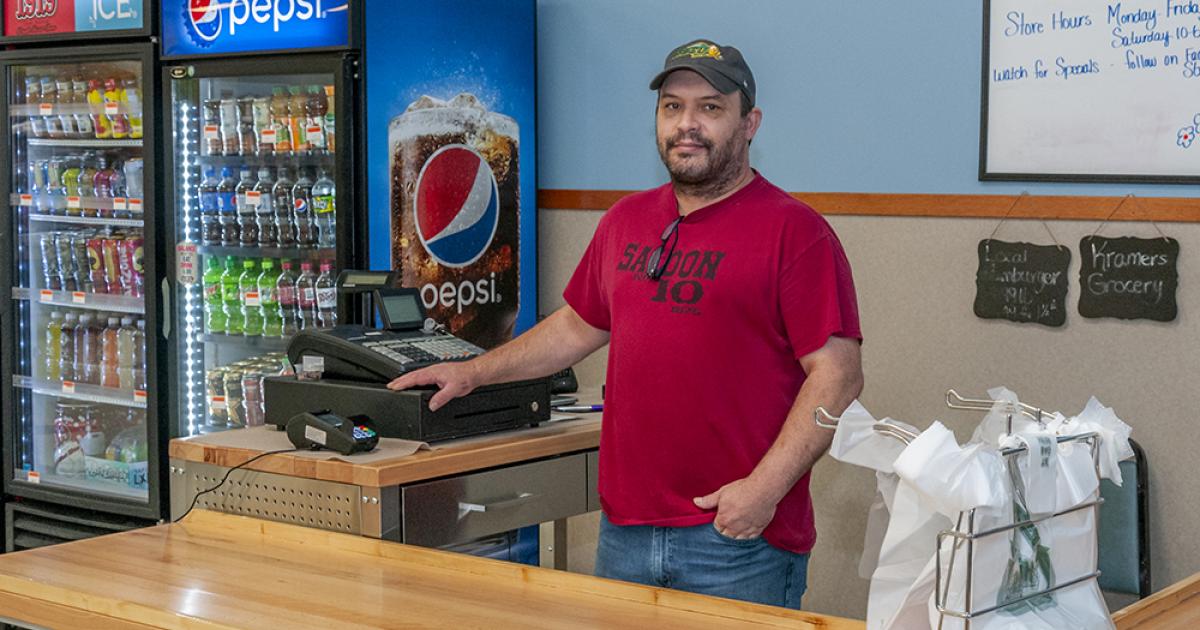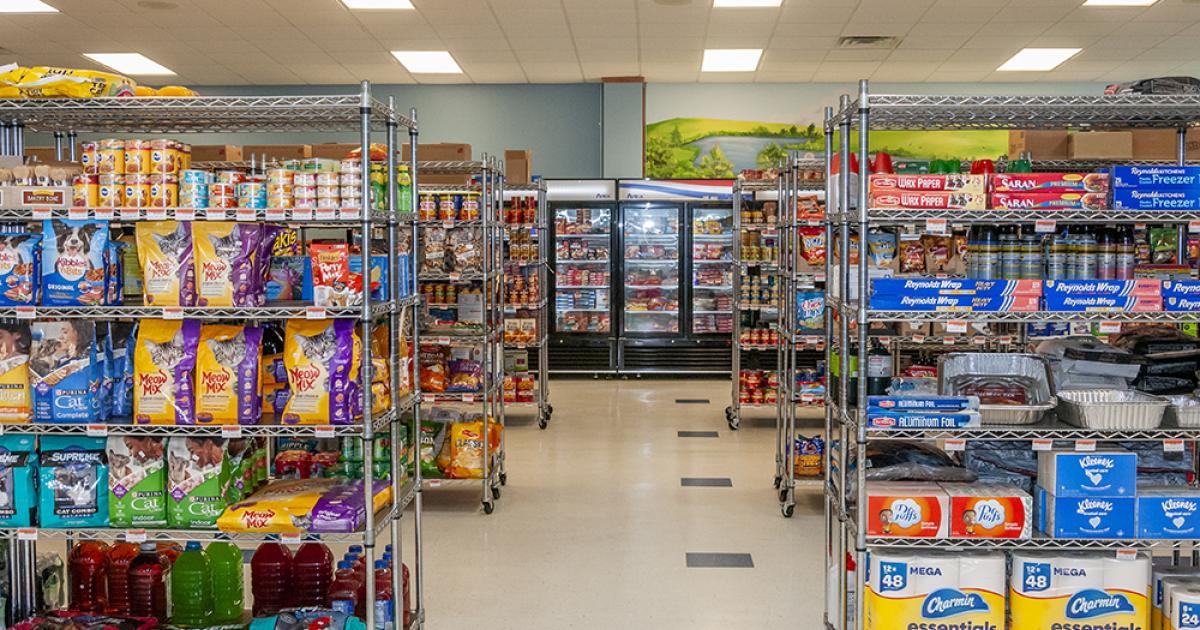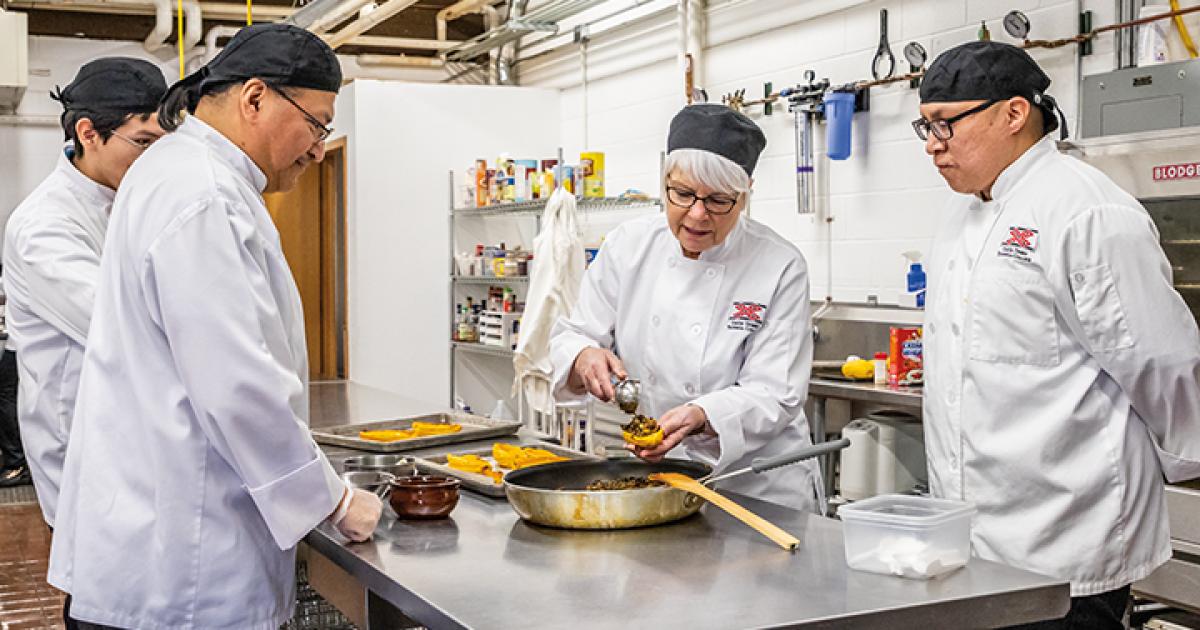Owner Mitch Kramer stands behind a mobile checkout counter at Kramer Grocery.
There’s nothing quite like the sound of a small-town dance hall – the rhythmic twang of a guitar, feet waltzing across the floor and the laughter of family and friends. In towns across North Dakota, dance halls are a place of community. And, for the people of Strasburg, the local dance hall has always held special significance.
Since the late 1800s, 622 Main Street has been the heart of the Strasburg community. Inside the walls of the Blue Room, generations have celebrated birthdays and graduations. Newlyweds have held each other close for their first dance, and the young ones learned to polka. Over the years, many musicians have taken the stage at the Blue Room, but the most legendary performer was an American accordionist, bandleader and television impresario.
“Strasburg is known for Lawrence Welk, and he played at the Blue Room. It’s been a landmark for years,” says Strasburg Mayor Sonya Schumacher. “When the original building burned down in 1999, the community got together and pooled donations, and they rebuilt it.”
Today, the Blue Room is the town’s only restaurant, offering friends and neighbors a place to gather.
“If you only try one thing, try the pizza,” says owner Mitch Kramer. “I make each pizza from scratch, so you can put anything on it. I’m a pineapple-on-pizza person. So, when I make my own, it’s pepperoni, Canadian bacon and pineapple.”
But what’s behind the restaurant has people talking.
Beyond a set of doors is a symbol of Strasburg’s past and hope for the small town’s future – an event pavilion that doubles as the local grocery store. It’s an innovative solution to a problem affecting many communities – local access to healthy foods.
North Dakota is losing rural grocery stores at an alarming rate, causing consumers to travel greater distances to access healthy food choices, such as fresh meat and produce. This disproportionately affects the elderly and low-income community members, who are left with few, if any, options to purchase healthy foods.
When Strasburg’s grocery store closed in 2019, Kramer saw an opportunity to serve his community, and he got to work. He purchased shelving and coolers, built portable walls and transformed the Blue Room pavilion into a multipurpose space.
“Everything is on wheels,” Kramer says. “When there’s an event, we push everything over to the wall, and then I put up a fake wall to hide everything. It takes about 45 minutes to an hour to tear it down and set it back up again.”
In January, Kramer’s Grocery welcomed its first customers. The store offers a wide variety of products, including cleaning supplies, homemade buns and fresh produce.
“I also sell local beef,” Kramer says. “The steaks are out of Napoleon, and the hamburger is out of Linton.”
And, remember those homemade pizzas? Kramer also sells a take-and-bake version for those who prefer to eat their pie at home.
“If you need anything, you can run down and get it,” Gary Keller says. “He’s got a pretty good supply.”
Lori Capouch, rural development director for the North Dakota Association of Rural Electric Cooperatives, believes this concept could prove beneficial in other rural communities.
“Across North Dakota, both rural grocery stores and restaurants struggle to keep their suppliers, due to low volumes and small customer bases,” Capouch says. “Mitch has cleverly combined the wholesale food needs of an existing restaurant with a newly opened grocery store in a shared community space. This concept is worthy of consideration by other communities that wish to bring their grocery store back. It’s an affordable option to keep local access to healthy foods.”
Kramer Grocery was financed, in part, through a participation loan offered by the Rural Development Finance Corporation (RDFC), a nonprofit finance and development corporation whose member-owners include North Dakota’s electric and telecommunications cooperatives. RDFC partnered with the Strasburg Economic Development Corporation to provide low-interest financing for the project, which also received grant funding from the Strasburg Lions Club.
“RDFC’s ability to provide low-interest financing while taking a secondary position on collateral is key to keeping rural businesses sustainable,” Capouch says. “Grocery stores are pillar businesses in a community. Without access to healthy food, communities suffer. Kramer Grocery is providing an important service to the Strasburg community.”
Today, new sounds fill the Blue Room. Close your eyes and you can hear them – the shuffle of groceries, the familiar tune of a grocery scanner, the robotic hum of a receipt printing.
One thing, however, has stayed the same – 622 Main Street is a pillar of this community, and it’s here to stay.
To learn more about RDFC, visit ndarec.com/content/rdfc-rural-development-finance-corporation.
___
Krista Rausch is a communications specialist with the North Dakota Association of Rural Electric Cooperatives. She can be reached at krausch@ndarec.com.











